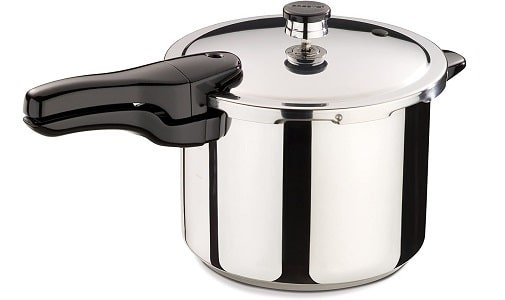Pressure cookers are cooking appliances that help produce healthful and flavorful meals. They make cooking quicker and faster and let you produce a variety of dishes, even on hectic weeknights. But like any other device, the cooker also might acquire troubles, and indeed the cooker not whistling seems to be a regular issue that many people confront.
If the cooker isn’t whistling, set the lid & gasket correctly. Wipe the pressure valve & lock its lid properly. Adjust the loose handle and change the gaskets if worn out. Limit the volume of liquid & food in the pressure cooker to recommended levels & give it the proper amount of heat.

When the pressure in a pressure cooker does not reach the proper level, the whistle does not sound. Continue reading to find out what one can do to correct the problem.
Reasons Why Pressure Cooker Is Not Whistling
1. Displaced lid position
The pressure vent on the pressure cooker allows the cooker to discharge excess pressure. The pressure vent for the pressure cooker is positioned on the top of the cooker. Because of this, if the lid is not properly positioned, the heat and pressure will not be allowed to pass via the pressure vent.
Furthermore, if the lid isn’t properly sealed, the pressure and heat will escape, & the pressure won’t be able to build up as it should. As a result, there will be no whistle from the pressure cooker.
Solution
It is necessary to lock the lid once again. Consequently, if you discover that the whistle also isn’t functioning, you must turn the heat down. After that, allow the pressure cooker to cool.
Using the lid, adjust the position of the lid to its proper position. Check to see if the pressure cooker is whistling once again by starting it up a second time.
2. Damaged & dirty gasket
When using a pressure cooker, the gasket might become damaged or worn over time. As a result, the excessive pressure will not be adequately released.
Furthermore, the filthy gasket can become dirty and filled from time to time. If you don’t cleanse the gasket after each cooking session, the gasket may become clogged and cease to function correctly.
Solution
If the gasket begins to show signs of wear, you might attempt to clean it. The gasket will need to be replaced if the unit is still not functioning properly. It is necessary to remove the broken gasket.
Furthermore, you must wash the gasket after each cooking session and re-attach it thereafter. Furthermore, if the cooker has been in use for several days, it is necessary to change the gasket with a fresh one.
3. Extra liquid
Adding an excessive amount of liquid during cooking may result in a problem. An ordinary pressure cooker works by converting liquid or water into steam.
As a result, if in case the pressure is high, the steam will escape. When you overfill the pressure cooker with liquid, it takes an excessive amount of time for the pressure to release or the whistle to sound, which is frustrating. Even the cooker may stop working entirely.
Solution
You can either study or follow the instructions in the pressure cooker’s instruction booklet. You will then be able to determine how much liquid you need to put into a certain cuisine. Cooking too much food in the pressure cooker is not recommended.
If you need to prepare a significant quantity of food, a huge pressure cooker is an excellent choice.
4. Too much food
If you cook a large amount of food at once in a cooker, the cooker may not be able to increase the temperature & pressure to the necessary levels. As a result, the excessive pressure will not be set free from the cooker. Thus, its whistle will be rendered ineffective.
Solution
Keep the amount of food in the cooker to a minimum. You can refer to the user handbook to get an idea of how much food one can put in the pressure cooker at any one time.
Furthermore, do not cook frozen food in a pressure cooker that has already been defrosted. First, defrost the food before beginning to prepare it.
Pressure cooker lids are equipped with a lock mechanism to ensure that the pressure within the pot is built up safely. In this case, the lid’s locking mechanism fails to provide the right fit that is necessary for steam to build inside the pot.
5. Insufficient Temperature
The whistle of a pressure cooker will not sound if it does not receive adequate heat, as the pressure within may not have built up to the requisite level in the first place.
Solution
Turn up the heat to a level that permits pressure to build up to the required limit before turning it off.
6. User Error
Make sure you’re following the instructions and safety guidelines for your specific pressure cooker model. Some cookers have unique features and requirements.
Conclusion
The distinct methods described above can be used to quickly and easily repair a pressure cooker whistle that has stopped working. You must follow the procedures outlined above for a quick and simple fix.
Santosh Kumar, the author behind IndiasStuffs.com, is passionate about sharing valuable insights on a variety of topics, including lifestyle, technology, and Indian culture.
Page Contents

